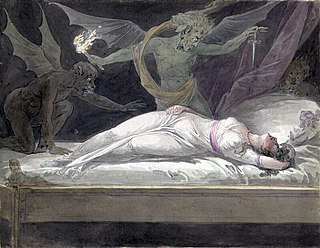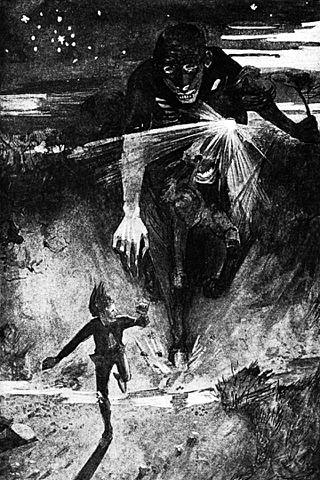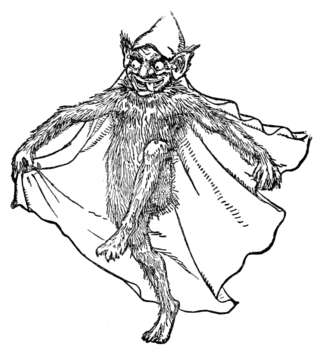Related Research Articles

A demon is a malevolent supernatural entity. Historically, belief in demons, or stories about demons, occurs in folklore, mythology, religion, and literature; these beliefs are reflected in media including comics, fiction, film, television, and video games. Belief in demons probably goes back to the Paleolithic age, stemming from humanity's fear of the unknown, the strange and the horrific. In ancient Near Eastern religions and in the Abrahamic religions, including early Judaism and ancient-medieval Christian demonology, a demon is considered a harmful spiritual entity that may cause demonic possession, calling for an exorcism. Large portions of Jewish demonology, a key influence on Christianity and Islam, originated from a later form of Zoroastrianism, and was transferred to Judaism during the Persian era.

A fairy is a type of mythical being or legendary creature, generally described as anthropomorphic, found in the folklore of multiple European cultures, a form of spirit, often with metaphysical, supernatural, or preternatural qualities.
Demonology is the study of demons within religious belief and myth. Depending on context, it can refer to studies within theology, religious doctrine, or occultism. In many faiths, it concerns the study of a hierarchy of demons. Demons may be nonhuman, separable souls, or discarnate spirits which have never inhabited a body. A sharp distinction is often drawn between these two classes, notably by the Melanesians, several African groups, and others. The Islamic jinn, for example, are not reducible to modified human souls. At the same time these classes are frequently conceived as producing identical results, e.g. diseases.

Leshy is a tutelary deity of the forests in pagan Slavic mythology. As Leshy rules over the forest and hunting, he may be related to the Slavic god Porewit.

Fallen angels are angels who were expelled from Heaven. The literal term "fallen angel" does not appear in any Abrahamic religious texts, but is used to describe angels cast out of heaven or angels who sinned. Such angels often tempt humans to sin.

An incubus is a demon in male form in folklore that seeks to have sexual intercourse with sleeping women; the corresponding spirit in female form is called a succubus. Parallels exist in many cultures.

A fairy ring, also known as fairy circle, elf circle, elf ring or pixie ring, is a naturally occurring ring or arc of mushrooms. They are found mainly in forested areas, but also appear in grasslands or rangelands. Fairy rings are detectable by sporocarps in rings or arcs, as well as by a necrotic zone, or a ring of dark green grass. Fungus mycelium is present in the ring or arc underneath. The rings may grow to over 10 metres (33 ft) in diameter, and they become stable over time as the fungus grows and seeks food underground.

The Nephilim are mysterious beings or people in the Hebrew Bible who are described as being large and strong. The Hebrew word Nephilim is sometimes translated as "giants", and sometimes as its literal meaning "the fallen ones". Their origins are disputed. Some, including the author of the Book of Enoch, view them as offspring of fallen angels and humans. Others view them as offspring of the descendants of Seth and Cain.
The kishi is a two-faced demon in Angola. According to legend, a kishi has an attractive human man's face on the front of its body and a hyena's face on the back. Kishi are said to use their human face as well as smooth talk and other charms to attract young women, who they then eat with the hyena face. The hyena face is said to have long sharp teeth and jaws so strong they cannot be pulled off anything it bites.

The nuckelavee or nuckalavee is a horse-like demon from Orcadian folklore that combines equine and human elements. British folklorist Katharine Briggs called it "the nastiest" of all the demons of Scotland's Northern Isles. The nuckelavee's breath was thought to wilt crops and sicken livestock, and the creature was held responsible for droughts and epidemics on land despite being predominantly a sea-dweller.

Leonard or Master Leonard is a demon or spirit in the Dictionnaire Infernal, grand-master of the nocturnal orgies of demons. He is represented as a three-horned goat, with a black human face. He marks his initiates with one of his horns. Infernal powers obtained from the worship of Master Leonard range from metamorphosis into monstrous animals or men to flight as an incubus.
Mythic humanoids are legendary, folkloric, or mythological creatures that are part human, or that resemble humans through appearance or character. Each culture has different mythical creatures that come from many different origins, and many of these creatures are humanoids. They are often able to talk and in many stories they guide the hero on their journey.

In Abrahamic religious traditions and some sects of other belief-systems like Hinduism and Buddhism, an angel is a heavenly supernatural or spiritual being. In monotheistic belief-systems, such beings are under service of the supreme deity.

A goblin is a small, grotesque, monstrous creature that appears in the folklore of multiple European cultures. First attested in stories from the Middle Ages, they are ascribed conflicting abilities, temperaments, and appearances depending on the story and country of origin, ranging from mischievous household spirits to malicious, bestial thieves. They often have magical abilities similar to a fairy or demon, such as the ability to shapeshift.
An Irshi is a type of mythical being or legendary fairy-like creature in Turkic folklore, a form of spirit, often described as supernatural or preternatural.

Div or dev are monstrous creatures within Persian lore. Most of their depictions derive from Persian mythology, integrated to Islam and spread to surrounding cultures including Armenia, Turkic countries and Albania. Despite their Persian origins, they have been adapted according to the beliefs of Islamic concepts of otherworldly entities. Although they are not explicitly mentioned within canonical Islamic scriptures, their existence was well accepted by most Muslims just like that of other supernatural creatures. They exist along with jinn, peri (fairies) and shayatin (devils) within South and Central Asian demon-beliefs.
References
- ↑ abookofcreatures (2015-05-01). "Kayeri". A Book of Creatures. Retrieved 2023-04-13.
- ↑ Mack, Carol K. (1999). A field guide to demons, fairies, fallen angels, and other subversive spirits. Dinah Mack (1st Owl books ed.). New York: Henry Holt and Co. ISBN 0-8050-6270-X. OCLC 40954064.
- ↑ Mack, Carol K. (2011). A Field Guide to Demons, Vampires, Fallen Angels and Other Subversive Spirits. Dinah Mack. New York: Skyhorse Publishing, Inc. ISBN 978-1-62872-150-8. OCLC 855503742.
- ↑ Mack, Carol; Mack, Dinah (1998). A Field Guide to Demons, Fairies, Fallen Angels, and Other Subversive Spirits. US: Arcade Pub. p. 121. ISBN 9781559704472.
- ↑ Arcand, Bernard; Simoneau, Karin; Wilbert, Johannes (1991). Folk literature of the Cuiva Indians. US: University of California. ISBN 9780879030797.